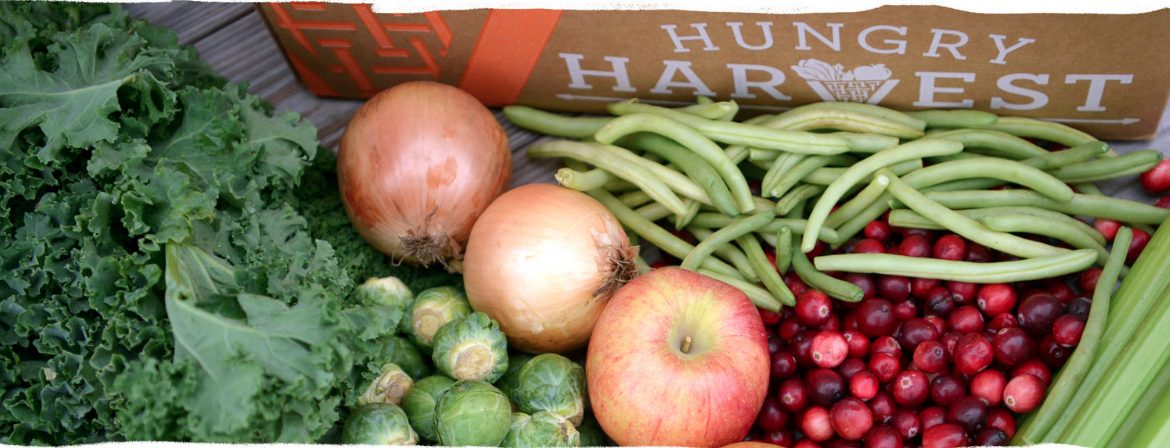Beginning in a University of Maryland dorm, Hungry Harvest has grown over the past six years into a formidable fresh produce delivery company that is working to eliminate food waste and feed the hungry.
With over 40 percent of food going to waste and 20 billion pounds of food thrown away before it even leaves the farm on which it was grown, the fact that 20 percent of the US lacks access to a nutritious diet is a cruel irony. But for Hungry Harvest, it’s a call to action, one that fuels their mission to fight both hunger and food waste while providing a service to the public.
Based in Baltimore and delivering to nine different areas around the eastern United States, including Richmond and Northern Virginia, Hungry Harvest is a bulk produce subscription service that works with farms and within the world of agriculture to make a positive environmental impact, reduce food waste, and feed the hungry. They work every day to bring their subscribers, and those in need, delicious locally-grown food that’s just a little off-size or ugly, as well as overproduced crops. They bring these fresh rescues straight to your door, and while doing so, have also provided over 800 pounds of donated food to their charitable partners.

RVA Mag was sent a box of their fresh harvest to try, and I was very impressed with what we received. Buying fresh produce is always a chore — having to make a trip, and plan in advance what meals we are going to make with them. With the delivery box, it was easy to just plan out what we could use in meals over the next few days. There is also an element of pleasant surprise, and some new veggies I might not find or notice at the store. You can also customize and pick exactly what you want for your order.

I was interested in learning more about how the company started, exactly how it does what it does, and the future plans for Hungry Harvest. I caught up with Even Lutz, the CEO and founder of the company, to dig deeper into their mission and his passion towards eliminating food waste.
Evan, what sparked your interest in food, farming, and agriculture?
When I was 10 years old, I was told about my great-great-grandfather, Abe Lutz, a first generation American, who was a farmer in Southern New Jersey. He didn’t speak any English, but he knew how to grow produce. Every day he made the 10-mile trek to South Philadelphia to sell his fruits and vegetables at a farm stand. But since the early 1900s, no one in the Lutz family has been in agriculture. I was so intrigued by his story that I insisted we visit Abe’s farm. My family took a trip to the 10-acre plot of land where my great-grandparents used to farm. We had the chance to talk to the current owners of the farm, and learned that they treat the land like the valuable resource it is. They don’t use pesticides, they practice modern farming techniques, and sell to local vendors in Philadelphia. That trip planted a seed within me to somehow continue my ancestors’ legacy of agriculture, and treat food with the respect it deserves.
Over the years, my curiosity about the origins and science of food increased exponentially. I was fortunate to be raised with home-cooked, healthy, and generally plant-based meals, where everything on the plate would be eaten. I loved helping my mom cook. Every day when I got home from school, I would help chop vegetables, measure out pasta, and preheat the oven. My favorite part of cooking was when I got to season the veggies in the stir fry. To this day I love cooking and eating healthy. I only wish everyone had access to the same healthy foods that I do. Unfortunately, an estimated 54 million this year do not.
What did you see about food waste that caught your attention?
Food is something we can all relate to. Everyone needs to eat, but too often it is taken for granted – unless of course, you don’t have enough. The reality is that hunger is something that too many people in our country face. In the US alone, 20 percent of people live in food insecurity, and yet 40 percent of our food goes to waste. Not only is that a huge problem, the environmental effects of food waste are detrimental to our planet and consequential to our health.
Each year, perfectly good food is wasted for the most ridiculous of reasons, including overproduction and rejections for being too big, too small, or too odd-looking. The result? Food waste statistics that are appalling. For example, it takes approximately 48 gallons of water to grow one pound of food — when we waste food, we are also wasting all of the resources used to grow it as well. Every year 19 percent of our fields are left unharvested. That’s the equivalent of wasting the crops from a farm the size of New Mexico!
In addition to the amount of natural resources wasted, the US spends $218 billion each year on food that goes to waste. Think of that for a second. That means every person in the US — man, woman, child — is spending $1.76 on food we don’t eat, every single day.
We simply cannot let this cycle of waste continue, so I choose to fight.

How did Hungry Harvest’s business start?
I started the concept for Hungry Harvest in my dorm basement. I was hauling 50-lb bags of produce up and down stairs to the farm stand, and desperately trying to get people to take a free sample. The beginning was tough, as I pleaded with the residence halls over spacing, and tried to work out the supply chain by myself. Yet I was determined to make this a success. Four months into the school project, we finally got some traction and started getting customers. I had proven the concept could work, but it was just the beginning of an uphill run.
In May of 2014, I graduated from the University of Maryland and started Hungry Harvest. I took the farm stand concept and turned it into a delivery model. I had no idea what I was doing, yet I was dedicated. Through the sweltering summer heat, I recruited some interns and went door knocking. Nobody had heard of “ugly produce” before, and food waste was not a big issue when we were first getting started in 2014. We were basically begging people to sign up for a free trial of our subscription service. After the first four months, having spent almost all of what was in our bank account, we only had 100 recurring customers to show for it — but we kept pushing forward. Fast forward to today, where with the help of our subscribers, we’ve expanded to deliver in nine different markets, and have rescued over 22 million pounds of food waste, while providing access to over 1.5 million pounds to those in need.
What’s your connection to Shark Tank?
The struggles of our first year were vindicated on June 17, 2015, when we made a deal with Robert Herjavec on Shark Tank. The tears shed on the show were raw emotion, as I flashed back to just how far we had come. Being on the show helped us increase awareness of the problems we were trying to solve, and validated the idea. We had a huge influx of customers as a result of the exposure on the show, which in turn helped us grow our impact.
Robert also helped us immensely in the early stage of the company. He advised us on how we could best create more robust, mature supply chain, marketing, and product strategies. He connected us with subject matter experts and folks from his own team who helped us navigate challenges and provide us insights to help us succeed.
How has Hungry Harvest grown from the early beginnings to now, and defined its mission? What challenges did you face along the way?
Our mission has always been clear: We believe every person has the right to eat healthy, and every fruit and vegetable deserves to be eaten. This idea guides everything we do, every employee, at every level. Logistically speaking, however, learning how to turn that idea into reality took time.
Figuring out our supply chain model was one of our biggest challenges. It was hard to decide how to order the right quantities and quality of produce. We started the company packing out of a partner’s unused warehouse space and relying upon friends and volunteers. Not a sustainable model — but that all changed once we saw growth in customer base and, subsequently, revenue from Shark Tank. Along with the revenue came innovations around how to scale our supply chain, which in turn created a better, higher-quality product. With a better product came more customers. Hungry Harvest picked up some local media. We were able to hire more team members. We expanded to Philadelphia. We minimized our weekly error rate to among the best in the industry.
I started to focus on team building & management. I dedicated myself to culture, and making Hungry Harvest a place where people wanted to work. We created core principles of our culture – honesty, transparency, and vulnerability.

How has COVID affected the business and people you work with?
The need for reliable home delivery of fresh, healthy food during the pandemic brought an enormous influx of demand to Hungry Harvest. We feel so lucky that we have been able to meet this need for our longtime customers, as well as the thousands of new subscribers per month who have joined more recently.
This is something we are careful not to take for granted. Because it is such a volatile time, we saw a chance to serve others who weren’t experiencing the same good fortune. With hearts full of gratitude, we decided to make this an opportunity to show even greater support for our community, our coworkers, and our customers.
Since March, we’ve partnered with several new local organizations to help ensure access to fresh, healthy produce in underserved communities. So far we have provided access to over 65,000 (and counting) emergency food boxes. Fostering relationships with these partners has not only gotten healthy food to people in need, but it has also created long-lasting partnerships with some truly wonderful organizations.
We’ve made it our top priority to ensure our staff feels safe and able to maintain a healthy work-life balance given the ever-changing and unprecedented circumstances. We ensured that all of our rigorous Good Manufacturing Processes have been strictly followed, including routine environmental cleaning; and that all Hungry Harvest staff have been trained in the most up-to-date health and safety practices, including glove use, proper use of all protective gear, and personal hygiene.
It was extremely important to us to make sure our subscribers knew that our commitment to continue produce deliveries would not waiver, so we actually temporarily stopped accepting new customers for a short period of time in order to make sure we were continuing to provide the highest level of service we possibly could.
What partnerships have been a part of Hungry Harvest in helping in its mission?
Helping is in the DNA of everything we do, so we are committed to finding the right ideas and people to help make that happen. Our hunger-fighting partners and farmers are our most important partners in executing our mission. In Richmond, we are working with VCU Ram Pantry to donate 300 pounds of produce every week to their program that fights food insecurity on campus.
Our mission has allowed us to develop relationships with community centers, hospitals, schools, and insurance companies to deliver food through our food access initiatives. Our Produce In A SNAP community markets, our COVID-relief Emergency Food Box program, and our “food is medicine” program, HarvestRX.
We also work with nutritionists, dietitians, and chefs to help bring the message of wellness home, showing folks how to use their entire Harvests once they have them in hand.
What do you see as the possible future of agriculture, farming, and connections to everyday people?
As climate change continues to become a more real and present danger, people will be forced to be more mindful of where their food comes from, what they choose to eat, and how that all contributes to either the solution or the problem. A greater focus on our food system means there will be more pressure for sustainable practices in farming and a demand for options that actively help mitigate climate change.
We want to be a part of the solution. Supporting farmers by rescuing food from going to waste will always be our primary goal and we see the mitigation of waste becoming a more critical factor in how consumers choose to spend their grocery dollars.

PLEASE check out hungryharvest.net, and use the code RVA50 for 50 percent off your order. For more info on Hungry Harvest, watch Evan Lutz’s TED Talk.



